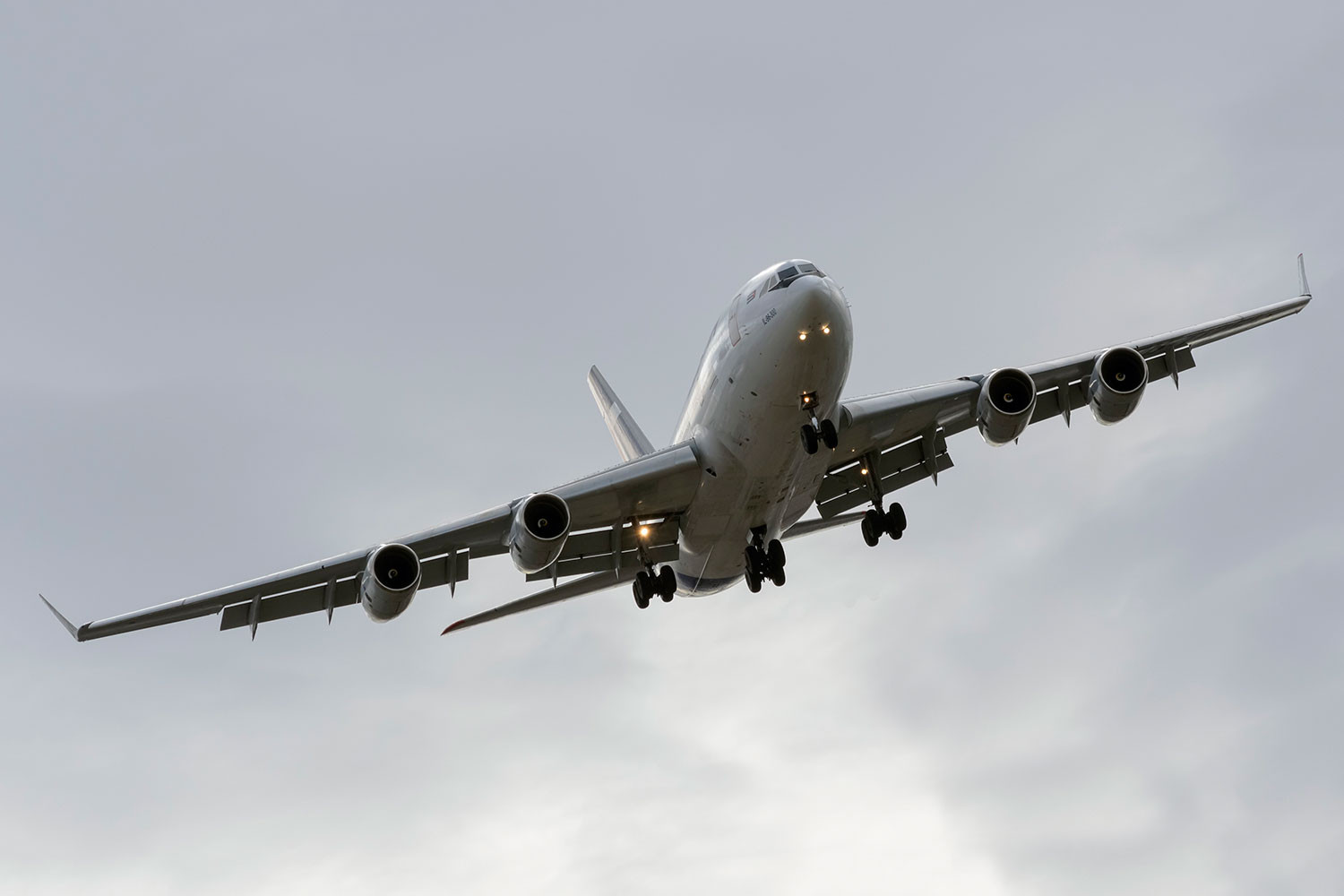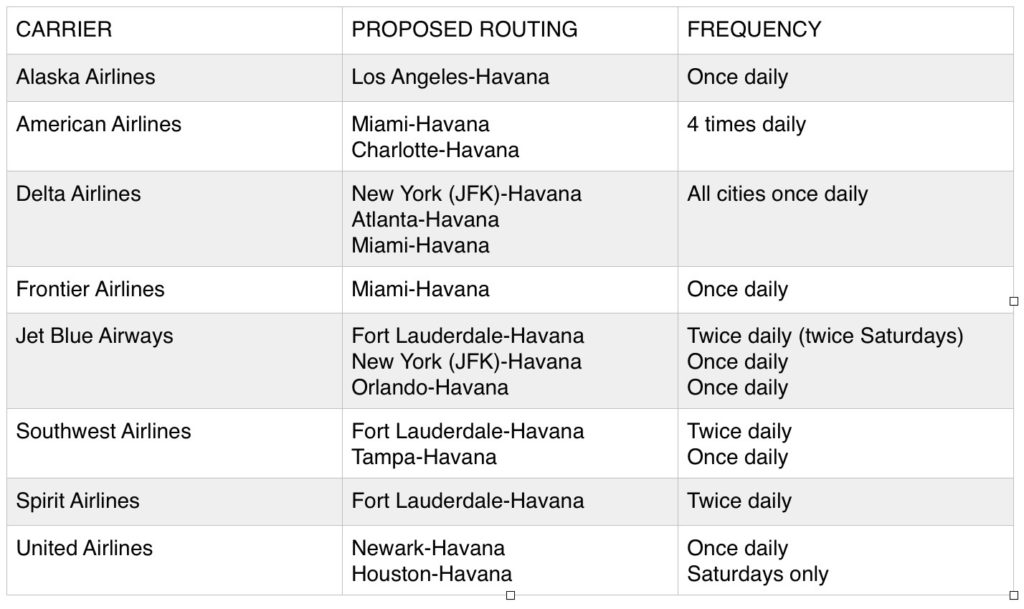
DOT fact sheet for U.S.-Cuba service to Havana
On February 16, 2016, Secretary Anthony Foxx and Department of State Assistant Secretary for Economic and Business Affairs Charles Rivkin signed an arrangement to re-establish scheduled air service between the United States and Cuba.
Under the new arrangement, each country has the opportunity to operate up to 20 daily roundtrip flights between the U.S. and Havana.
DOT is conducting a carrier selection proceeding and has reviewed applications from the 12 U.S. airlines competing for the chance to operate scheduled passenger flights to Havana. The Department’s principal objective in making its proposed selections was to maximize public benefits, including choosing airlines that offered and could maintain the best ongoing service between the U.S. and Havana.
Objections to DOT’s tentative decision are due by July 22. If objections are filed, answers to objections will be due July 29. DOT expects to reach a final decision later this summer. The tentative decision and other documents in the case are available on the internet at www.regulations.gov, Docket DOT-OST-2016-0021.
Q &A
Q. Why did DOT issue this tentative decision, and what does it do?
A. 12 U.S. carriers filed applications to conduct scheduled combination services (i.e., passenger and cargo) to Havana. Collectively the airlines applied for nearly 60 flights per day into Havana, exceeding the 20 daily flights made available by the U.S.-Cuba arrangement. Because the applicants seek more opportunities than are available under the U.S.-Cuba arrangement, DOT is conducting a proceeding to allocate the opportunities in a manner that will maximize public benefits.
At this stage, DOT has issued a tentative decision. DOT has proposed selecting eight U.S. airlines to begin scheduled flights between ten U.S. cities and Havana, Cuba. After reviewing the comments filed in response to the tentative decision, DOT will issue a final decision actually awarding authority.
Q. Why is this a tentative decision, and when will DOT make a final decision?
A. In contested carrier selection cases DOT routinely makes a tentative decision via a show cause order. This accords due process by allowing interested parties to comment on DOT’s proposed actions before they are made final. Objections to DOT’s tentative decision are due by July 22. If objections are filed, answers to objections will be due July 29. DOT expects to reach a final decision later this summer.
Q. Which airlines were tentatively selected, from which U.S. cities to Havana, and how often? A. The tentatively selected airlines, routes, and proposed frequency are summarized in the table below: 
Q. Why these cities and why these carriers?
A. In the tentative decision, DOT stated that this proceeding provides an opportunity to introduce scheduled service to Havana after more than 50 years of U.S.-Cuba services being absent altogether or limited only to charters. DOT said that in cases where it has the opportunity to introduce U.S. carrier service where it has been unavailable or significantly restricted, it typically makes selections designed to address a variety of public interest needs. It pursued that approach here.
Q. Why was my city not selected for service to Havana?
A. In the order, DOT noted that with the limitations on scheduled Havana service and the number of requests received, DOT could not select every applicant or every city for service. Because this matter is pending before the Department, we cannot provide any substantive comments regarding the case or the merits of any of the proposals submitted. Interested parties can track the progress of the case and read the Department’s order, available online at www.regulations.gov, by searching for Docket DOT- OST-2016-0021.
Q. Why was a particular airline not selected for service to Havana?
A. Given the limitations on scheduled Havana service and the number of requests received, DOT could not select every applicant for service. DOT’s show cause states that the carriers and cities tentatively selected represent, on balance, the best approach to achieve maximum public benefits.
Interested parties can track the progress of the case and read the Department’s order, available online at www.regulations.gov, by searching for Docket DOT-OST-2016-0021.
Q. When can I buy a ticket for a scheduled flight to Havana?
A. DOT has only issued a tentative decision, and airlines will not be authorized to sell tickets until a final decision is reached sometime later this summer. Most of the airlines propose to begin their services in the fall and winter of 2016/2017, and those airlines receiving authority in the proceeding will likely begin selling tickets well in advance of their planned startup dates.
Q. When will flights to Havana start?
A. DOT has only issued a tentative decision, and airlines will not be authorized to sell tickets or operate scheduled flights until a final decision is reached sometime later this summer. The airlines have proposed varying startup dates for their services, but most are planned for fall and winter 2016/2017. DOT’s decision contains requirements that, if made final, will require that the carriers begin their services within 90 days of the issue date of a final order.
Q. What opportunities are available under the U.S.-Cuba arrangement?
A. Under the terms of the U.S.-Cuba arrangement, the DOT may allocate up to 20 daily round-trip frequencies for U.S. carrier scheduled passenger or all-cargo services between the United States and Havana. For scheduled passenger or all-cargo services to and from each of the other nine international airports in Cuba, DOT may allocate up to 10 daily round-trip frequencies at each airport, for a total of 90 daily non-Havana U.S.-Cuba round-trip frequencies. There are no frequency restrictions on charter service.
Q. Where can I find the text of the U.S.-Cuba arrangement?
A. The text of the arrangement can be found on the Department of State’s website at
http://www.state.gov/e/eb/rls/othr/ata/c/cu/252525.htm.
Q. What will happen to the current charter services between the U.S. and Cuba?
A. The U.S.-Cuba arrangement allows for unlimited charter services to and from any point in Cuba, and the proceeding accordingly is not addressing charter services, which will continue as before. DOT’s sole focus in this proceeding is on the allocation of scheduled service frequencies to Havana.
Q. How will these new services be impacted by the remaining laws and regulations pertaining to Cuba travel?
A. While the new arrangement reflects a major step forward in President Obama’s policy of engagement with Cuba, the Department recognizes that significant limitations and requirements remain in place concerning air transportation between Cuba and the U.S. For example, travel for tourist activities remains prohibited by statute. Any award of authority in this proceeding will not relieve parties from complying with the applicable requirements and regulations of other U.S. agencies, and with all applicable laws of the United States.
Q. Does this tentative decision mean that I can travel to Cuba as a tourist?
A. No. While the new arrangement reflects a major step forward in President Obama’s policy of engagement with Cuba, the Department recognizes that significant limitations and requirements remain in place concerning air transportation between Cuba and the U.S. For example, travel for tourist activities remains prohibited by statute. Any award of authority in this proceeding will not relieve parties from complying with the applicable requirements and regulations of other U.S. agencies, and with all applicable laws of the United States. This new arrangement will facilitate visits for travelers that fall under one of 12 categories authorized by the U.S. Department of the Treasury’s Office of Foreign Assets Control (OFAC). Prospective travelers should also review OFAC’s Frequently Asked Questions Related to Cuba.


